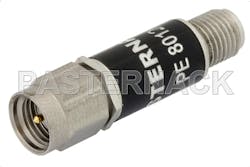Exploring Types of RF Microwave Detectors
A radio frequency (RF) microwave detector, also known as RF power detector or RF responding detector, is a two-terminal device used to detect, and in some way, measure or convert an RF signal. As the receiving element, an RF detector is used in converting amplitude-modulated microwave signals to baseband (or video) signals in either a wireless or wired transmission. In RF circuits and systems, RF microwave detectors can detect the transmit power level of the RF signal in a particular frequency range. Another application of RF microwave detectors is to measure transmitter output power; as knowing the RF output power is crucial in not exceeding certain maximum transmitter power levels according to Federal Communications Commission regulations, and other international regulations.
The two main categories of detectors are peak and Root Mean Square (RMS). Peak detectors provide information on the peak power whereas RMS detectors provide information on the average power.
Peak detectors – also known as envelope detectors, capture the extreme of the voltage signal at its input. A positive peak detector captures the most positive point of the input signal and a negative peak detector captures the most negative point of the input signal. The output of the peak detector circuit tracks the input voltage until the extreme point is reached and holds that value as the input decreases. Ideally, the peak detector performs this function regardless of the speed of the input signal but is limited by the bandwidth of the input signal. A peak detector uses an amplifier, diode, and capacitor to capture and hold the peak value of the input RF signal. The signal charges the capacitor through the amplifier, and the diode prevents discharge of the capacitor. This is useful when the peak or maximum RF signal value is needed but it is not useful for determining average or any other sort of non-peak value.
RMS detectors – thermal detectors (power detectors) and square law detectors.
Thermal detectors like bolometers (e.g. thermistor or thermocoupler) convert the electrical power of the RF signal into thermal energy using a resistive component and then measure the temperature variation with respect to the ambient temperature. Advantages of this method are a very wide bandwidth and a good accuracy between measured power and real power. Examples include: Thermocoupler, a pair of dissimilar metal (Sb-Bi) wires joined at one end (sensing end) and terminated at the other end (reference end); Barretter: a short length of platinum or tungsten wire with a positive temperature coefficient of resistance; Crystal detector which uses the diode square-law to convert input microwave power to detector output voltage; and Schottky barrier or GaAs barrier diode which has high sensitivity noise equivalent power and the lowest detectable microwave signal power.
Square law detectors use the characteristics of semiconductors components (diodes or transistors) to convert a voltage into a signal proportional to the RF power which is typically low-pass filtered to realize the average operation. This kind of component is particularly useful for high frequency and low cost applications.
There are several other types of RF detectors, and detectors are also packaged in a variety of ways based on their application requirements. Inline coaxial assemblies and waveguide assemblies are the most common. There are log detectors, which convert a wide dynamic range signal into a logarithmic output, thus enabling an artificially enhanced dynamic range. There are also Zero Bias detectors, which apply diode detector devices that don’t require a bias voltage or current to operate, and are often used in low-power and passive applications (RFID). RF Threshold detectors convert an RF signal over a specific frequency range to a DC equivalent voltage. Lastly, there are Waveguide Detectors, which are simply an RF detector built into a waveguide housing.
Learn More about Pasternack’s RF detectors:
Waveguide Detectors:
https://www.pasternack.com/nsearch.aspx?Category=Waveguide%20Detectors&sort=y&view_type=grid
Log Detectors:
https://www.pasternack.com/50-ohm-sma-log-detector-positive-10-mhz-3000-mhz-pe8040-p.aspx
Threshold Detectors:
Zero Bias Detectors:
